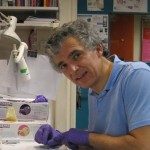Link to Pubmed [PMID] – 12493753
J. Biol. Chem. 2003 Mar;278(13):11320-30
Three-dimensional models of the catalytic domains of Nudel (Ndl), Gastrulation Defective (Gd), Snake (Snk), and Easter (Ea), and their complexes with substrate suggest a possible organization of the enzyme cascade controlling the dorsoventral fate of the fruit fly embryo. The models predict that Gd activates Snk, which in turn activates Ea. Gd can be activated either autoproteolytically or by Ndl. The three-dimensional models of each enzyme-substrate complex in the cascade rationalize existing mutagenesis data and the associated phenotypes. The models also predict unanticipated features like a Ca(2+) binding site in Ea and a Na(+) binding site in Ndl and Gd. These binding sites are likely to play a crucial role in vivo as suggested by mutant enzymes introduced into embryos as mRNAs. The mutations in Gd that eliminate Na(+) binding cause an apparent increase in activity, whereas mutations in Ea that abrogate Ca(2+) binding result in complete loss of activity. A mutation in Ea predicted to introduce Na(+) binding results in apparently increased activity with ventralization of the embryo, an effect not observed with wild-type Ea mRNA.
